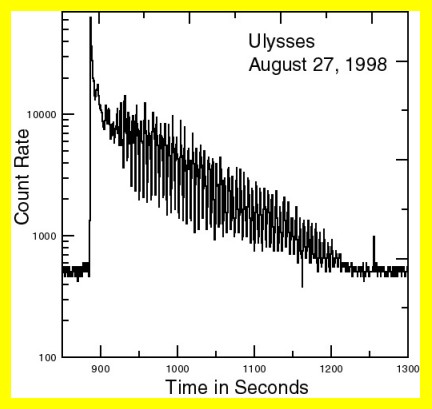
|
Credit & Copyright: Kevin Hurley
(Space Sciences Laboratory)
Explanation:
On August 27th
an intense flash of X-rays
and gamma-rays swept through our Solar System.
Five spacecraft of the
Third InterPlanetary gamma-ray burst Network,
Ulysses,
WIND,
RXTE,
NEAR, and
BeppoSAX,
recorded the high energy signal --
a signal so strong that it saturated detectors on WIND and RXTE and
triggered the safety mode
automatic shut-off of the NEAR gamma-ray instrument!
As plotted here, the count rate for the Ulysses detector abruptly
spiked to a high level and then slowly tailed off showing
smaller peaks roughly every 5 seconds.
The signal and location provided by these spacecraft observations leads
researchers to identify the source as a dramatic flare-up from
one of only
four previously known "Soft Gamma Repeaters" .
These exotic
sources of gamma-rays are believed to be
highly magnetized spinning neutron stars
called Magnetars.
Imaginatively cataloged as
SGR 1900+14, this magnetar
is estimated to have been
born in a supernova explosion
about 1,500 years ago and to have a magnetic field
500,000,000,000,000 times stronger
than Earth's.
|
January February March April May June July August September October November December |
| ||||||||||||||||||||||||||||||||||||||||||||||||
NASA Web Site Statements, Warnings, and Disclaimers
NASA Official: Jay Norris. Specific rights apply.
A service of: LHEA at NASA / GSFC
& Michigan Tech. U.
Based on Astronomy Picture
Of the Day
Publications with keywords: magnetar - soft gamma repeater - neutron star
Publications with words: magnetar - soft gamma repeater - neutron star
See also:
- GW200115: Simulation of a Black Hole Merging with a Neutron Star
- A Hotspot Map of Neutron Star J0030s Surface
- Unusual Signal Suggests Neutron Star Destroyed by Black Hole
- The Lonely Neutron Star in Supernova E0102 72.3
- NGC 4993: The Galactic Home of an Historic Explosion
- GW170817: A Spectacular Multiradiation Merger Event Detected
- Cooling Neutron Star
